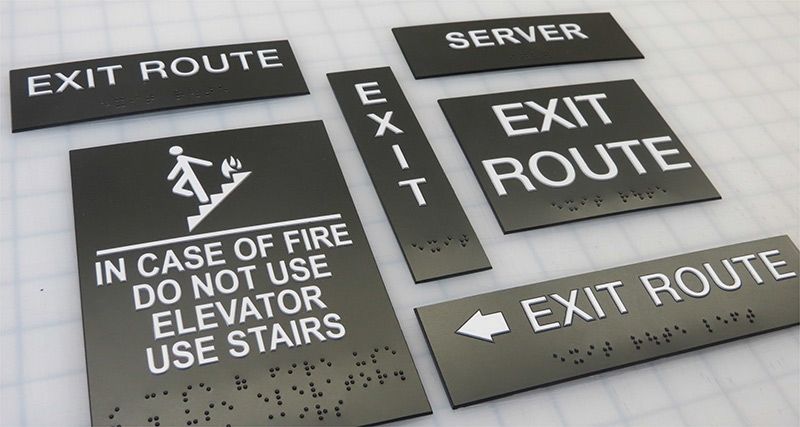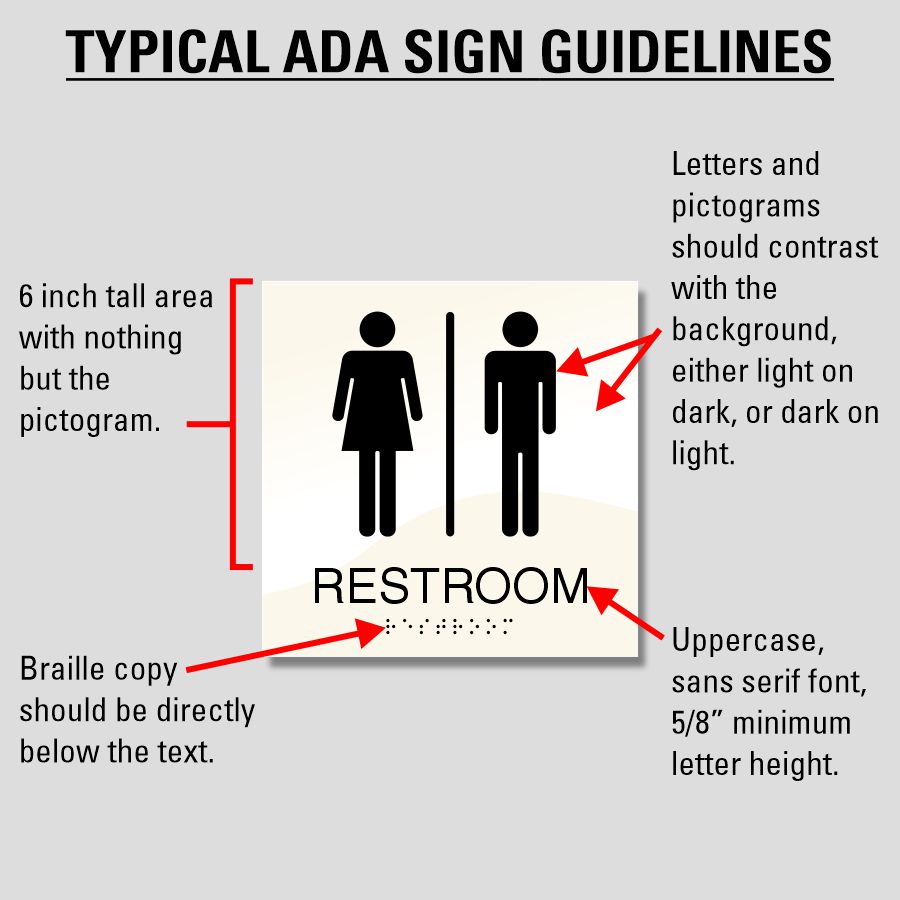How ADA Signs Improve Availability for Everyone
How ADA Signs Improve Availability for Everyone
Blog Article
Checking Out the Trick Functions of ADA Indicators for Boosted Accessibility
In the realm of accessibility, ADA signs offer as quiet yet powerful allies, making certain that rooms are accessible and inclusive for individuals with disabilities. By incorporating Braille and tactile elements, these signs damage barriers for the aesthetically impaired, while high-contrast shade systems and understandable font styles cater to varied visual needs.
Relevance of ADA Compliance
Making sure conformity with the Americans with Disabilities Act (ADA) is important for fostering inclusivity and equal accessibility in public spaces and work environments. The ADA, established in 1990, mandates that all public centers, employers, and transportation services accommodate individuals with disabilities, ensuring they take pleasure in the exact same rights and possibilities as others. Compliance with ADA criteria not only fulfills legal obligations yet additionally enhances a company's reputation by showing its dedication to variety and inclusivity.
One of the vital aspects of ADA compliance is the implementation of accessible signs. ADA signs are developed to guarantee that individuals with handicaps can easily navigate through rooms and buildings.
In addition, adhering to ADA guidelines can reduce the threat of potential fines and legal consequences. Organizations that fail to adhere to ADA standards might encounter penalties or lawsuits, which can be both damaging and financially difficult to their public image. Hence, ADA compliance is integral to fostering an equitable setting for everyone.
Braille and Tactile Aspects
The consolidation of Braille and responsive elements into ADA signs symbolizes the concepts of ease of access and inclusivity. These attributes are crucial for individuals that are visually impaired or blind, enabling them to navigate public areas with greater self-reliance and confidence. Braille, a tactile writing system, is crucial in providing composed details in a format that can be conveniently viewed with touch. It is typically put beneath the equivalent message on signs to ensure that individuals can access the details without visual aid.
Responsive aspects extend past Braille and include increased characters and symbols. These components are made to be noticeable by touch, allowing people to recognize space numbers, washrooms, exits, and various other vital locations. The ADA sets details standards regarding the dimension, spacing, and positioning of these tactile components to enhance readability and make sure consistency across different atmospheres.

High-Contrast Shade Plans
High-contrast color pattern play a pivotal role in boosting the visibility and readability of ADA signs for people with visual problems. These schemes are necessary as they maximize the distinction in light reflectance in between message and background, making sure that indicators are conveniently discernible, also from a distance. The Americans with Disabilities Act (ADA) mandates the usage of details color contrasts to suit those with minimal vision, making it a crucial aspect of conformity.
The effectiveness of high-contrast colors hinges on their capability to stick out in different lighting conditions, including poorly lit settings and areas with glare. Typically, dark text on a light background or light text on a dark history is used to achieve ideal comparison. For example, black text on a white or yellow background offers a stark visual difference that aids in fast acknowledgment Visit This Link and comprehension.

Legible Fonts and Text Dimension
When considering the layout of ADA signage, the selection of readable font styles and suitable message size can not be overemphasized. The Americans with Disabilities Act (ADA) mandates that fonts should be not italic and sans-serif, oblique, script, very attractive, or of unusual kind.
According to ADA standards, the minimal text height should be 5/8 inch, and it should increase proportionally with checking out range. Consistency in text dimension contributes to a natural aesthetic experience, assisting people in browsing settings efficiently.
Additionally, spacing between letters and lines is essential to readability. Appropriate spacing protects against personalities from showing up crowded, improving readability. By adhering to these requirements, developers can considerably enhance access, guaranteeing that signs serves its intended function for all individuals, no matter their visual capabilities.
Effective Placement Approaches
Strategic positioning of ADA signs is crucial for maximizing access and guaranteeing conformity with legal requirements. ADA guidelines state that indications should be placed at a height between 48 to 60 inches from the ground to ensure they are within the line of sight for both standing and seated individuals.
Additionally, indications have to be put beside the latch side of doors to enable very easy identification before entry. This placement helps people locate rooms and rooms without blockage. In cases where there is no door, indications need to be positioned on the nearest nearby wall surface. Uniformity in sign placement throughout a facility improves predictability, minimizing complication and enhancing overall individual experience.

Final Thought
ADA indicators play an essential try this web-site function in promoting access by integrating functions that address the demands of individuals with specials needs. Integrating Braille and tactile aspects guarantees critical information is accessible to the aesthetically impaired, while high-contrast color pattern and understandable sans-serif font styles boost presence across different lighting conditions. Effective placement methods, such as suitable placing heights and calculated locations, even more promote navigating. These elements collectively cultivate a comprehensive setting, emphasizing the relevance of ADA compliance in guaranteeing equivalent accessibility for all.
In the world of ease of access, ADA indicators serve as silent yet powerful allies, guaranteeing that rooms are inclusive and accessible check out here for individuals with handicaps. The ADA, enacted in 1990, mandates that all public facilities, employers, and transport solutions suit individuals with specials needs, guaranteeing they appreciate the very same civil liberties and possibilities as others. ADA Signs. ADA indicators are made to make sure that individuals with impairments can easily browse through rooms and buildings. ADA standards state that signs ought to be placed at a height between 48 to 60 inches from the ground to ensure they are within the line of view for both standing and seated people.ADA signs play an essential duty in promoting access by incorporating attributes that attend to the requirements of individuals with disabilities
Report this page